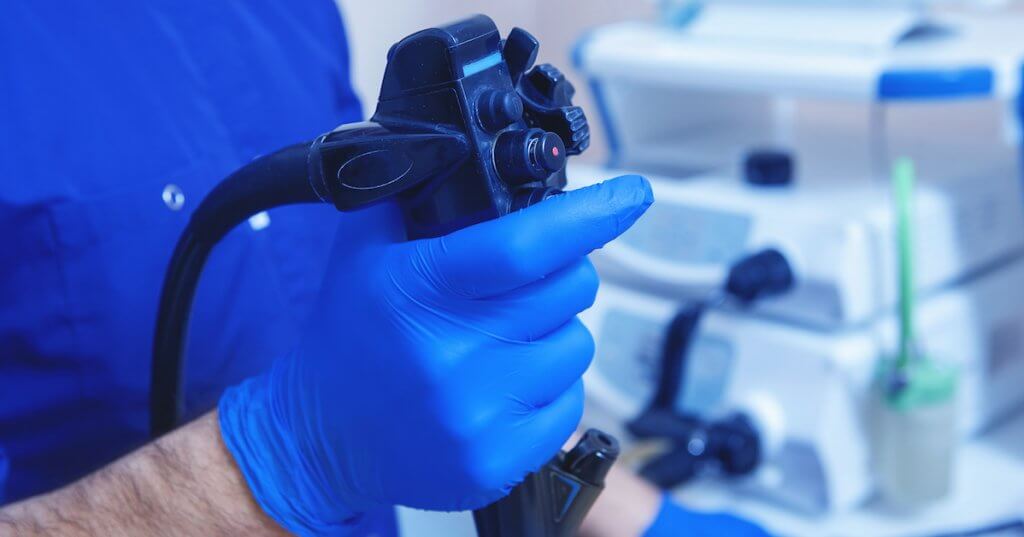Endoscopy or Colonoscopy: Which Do I Need?

Gastroenterologists commonly use a procedure like an endoscopy or colonoscopy to diagnose conditions that cause symptoms like abdominal pain, bleeding, acid reflux, nausea, vomiting, and diarrhea. Both tests can diagnose GI disorders and diseases, but which do you need and when?
What is an Endoscopy?
When someone uses the term “endoscopy,” they are usually referring to an upper endoscopy. An upper endoscopy is a procedure that allows your doctor to visualize your upper GI tract. Common conditions endoscopies can diagnose include GERD, esophageal motility disorders, and esophageal cancer. Gastroenterologists usually perform endoscopies to diagnose GI disorders, but sometimes the doctor uses endoscopy to administer treatment.
During an upper endoscopy, the doctor inserts a device called an endoscope into the mouth and feeds it down through the esophagus and upper digestive tract. The doctor may inflate your throat slightly with gentle air pressure to allow the scope to move more freely. The endoscope is a long, flexible tube with a camera at the end. As the doctor moves the scope down the esophagus, the camera transmits images to monitors for the doctor to examine.
The doctor can also use the endoscope to take tissue samples or remove polyps from the esophagus. Using the video monitor for guidance, the doctor passes small surgical instruments through the scope. When the exam is complete, and the necessary samples have been taken, the doctor slowly pulls the endoscope back up the esophagus and through your mouth.
An upper endoscopy usually takes about 15 to 30 minutes. You may be given a mild sedative to help you relax during the procedure. Additionally, anesthetic spray applied to the throat can ease discomfort. Some people report feelings of fullness and pressure during an upper endoscopy, but it should not be painful.
There is also a diagnostic procedure called a small bowel capsule endoscopy. During this procedure, the patient swallows a tiny camera to take pictures of the digestive tract. Capsule endoscopies allow doctors to examine the small intestine, which is harder to reach during a traditional endoscopy.
When is an Endoscopy Needed?
- Investigation symptoms and confirm diagnoses: Endoscopies allow doctors to visualize the upper GI tract to find the cause of symptoms like abdominal pain, nausea, vomiting, difficulty swallowing, reflux, or GI bleeding.
- Collecting tissue samples for biopsies: Physicians don’t just use an endoscope to visualize the upper digestive tract. The scope allows them to take tissue samples for biopsies. Biopsy results can help the doctor make or confirm a diagnosis.
- Treatment: Certain treatments require the use of an endoscope. The doctor can pass tools through the endoscope to remove polyps, remove foreign objects, or widen the esophagus.
What is a Colonoscopy?
A colonoscopy is a procedure used to detect abnormalities or changes in the tissue of the large intestine, or colon, and rectum. Abnormal tissues or growths like polyps can be a sign of colon cancer. During a colonoscopy, a long, flexible tube called a colonoscope is used. The colonoscope has a tiny video camera at the tip of the instrument. The doctor inserts the scope into the rectum, and the camera transmits images of the inside of the colon.
If there are abnormal types of tissue or polyps found during the colonoscopy, the doctor can remove them through the scope as well. Biopsies samples for further testing can be collected during the exam as well. These tests can detect cancerous cells or other signs of intestinal problems.
During a colonoscopy, the patient is sedated and given medication to prevent discomfort during the procedure. The sedative and pain medication can be given as a pill or intravenously. Some people report feeling abdominal cramping when the scope is inserted, but most people don’t feel any discomfort during the procedure. Recovery takes about an hour following the colonoscopy. However, it would be best if you did not drive or go back to work for at least a day.
Why Would I Need a Colonoscopy?
- Diagnostic testing to investigate symptoms: A colonoscopy allows your doctor to view the inside of your colon, which can help in determining the cause of symptoms like chronic diarrhea, constipation, rectal bleeding, or abdominal pain.
- Routine colon cancer screening: According to the Centers for Disease Control and Prevention (CDC), adults over the age of 50 should get a colonoscopy to screen for colon cancer. People with conditions like inflammatory bowel disease or a family history of colon cancer should be screened earlier.
- Follow up screenings: For people not at an increased risk for colon cancer, experts recommend a colonoscopy every ten years. However, if they found polyps during a previous screening, you will need to be checked more frequently.
At Birmingham Gastroenterology, our board-certified physicians perform several GI tests and procedures, including colonoscopies and endoscopies. Our doctors and staff are experts in diagnosing and treating diseases and disorders of the upper GI tract, lower GI tract, pancreas, gallbladder, and liver. So if you’re experiencing symptoms and want to talk to an expert about endoscopy or colonoscopy, call (205) 271-8000 to make an appointment.

